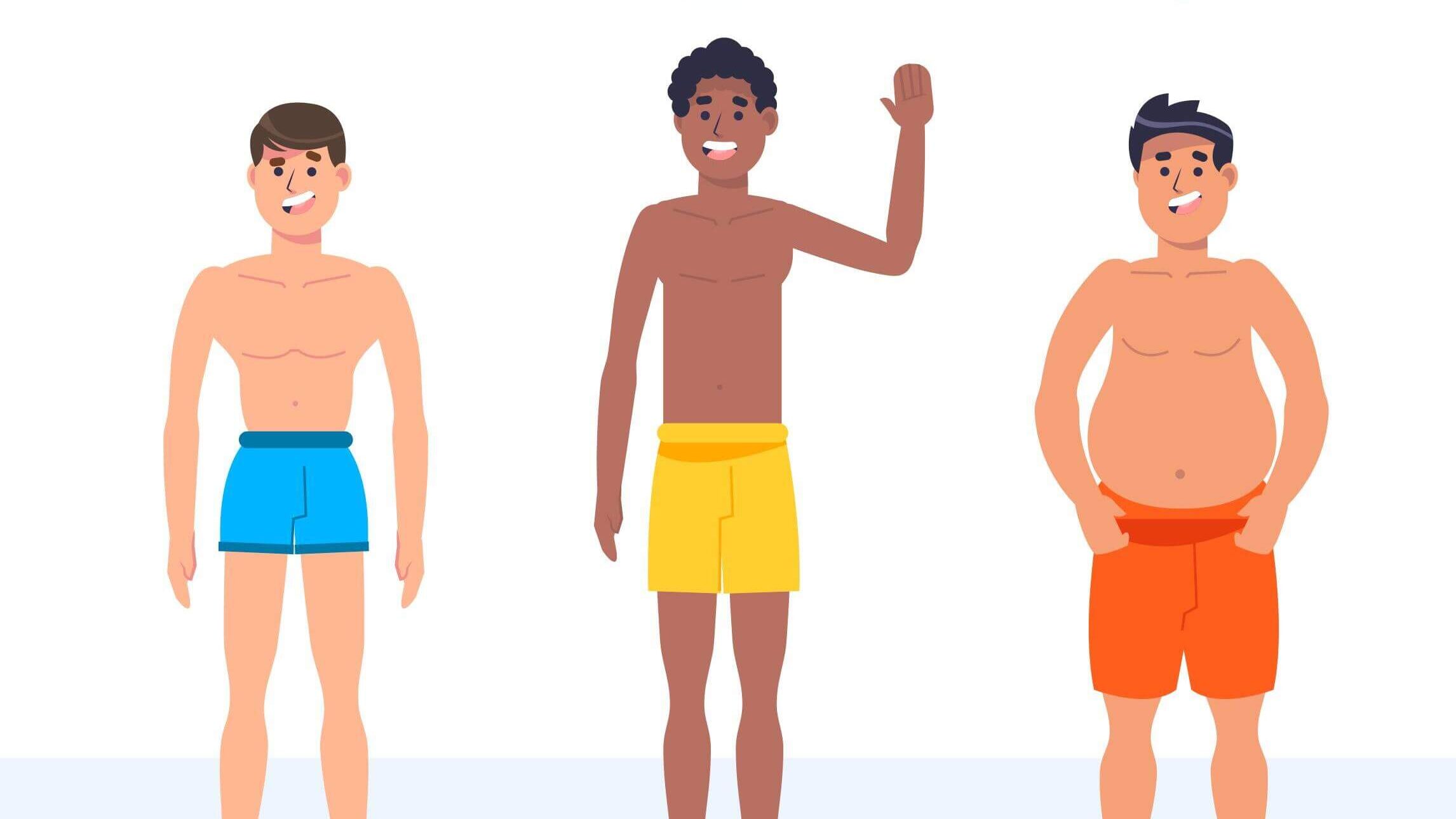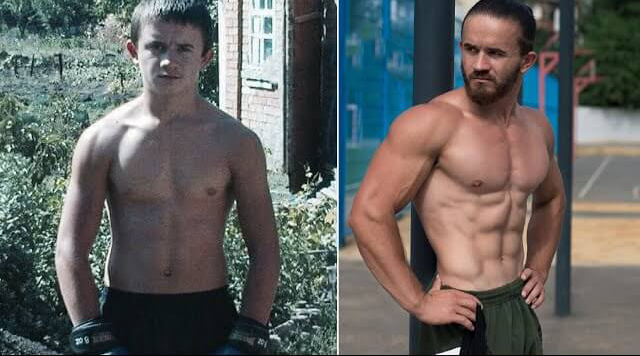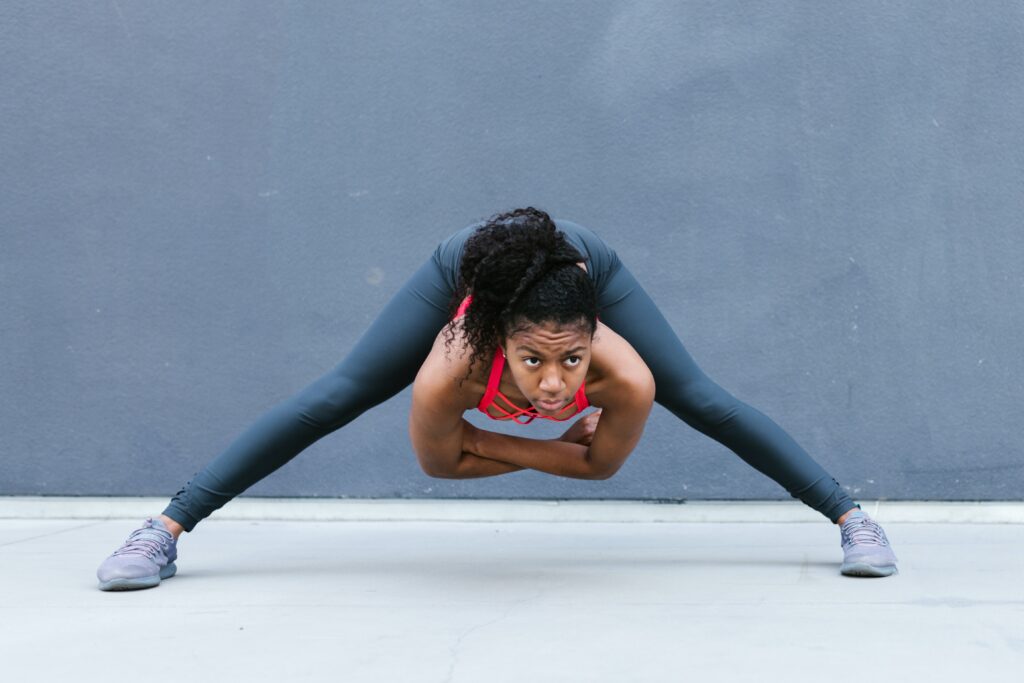Calisthenics Body Type: Mastering Your Fitness Potential in Just 5 Minutes!
Hey there, fitness enthusiast! If you’re passionate about training and staying in shape, you’re in for a treat. Today, we’re diving into the fascinating world of calisthenics and how your unique calisthenics body type plays a crucial role in this incredible form of exercise.
Definition of Calisthenics: First things first, what exactly is calisthenics? Well, think of it as a fitness discipline that revolves around using your body weight for resistance. Forget heavy barbells and complex machines; with calisthenics, you rely on exercises like push-ups, pull-ups, squats, and planks to build strength, flexibility, and endurance. It’s the art of mastering your body.

Importance of calisthenics body type
Now, let’s get to the interesting part. Your calisthenics body type matters a lot. You see, we’re all unique, and our bodies come in different shapes and sizes. These differences can influence how you perform certain calisthenics exercises and even how quickly you progress.
Purpose of the Blog Post: Calisthenics body types
So, why are we talking about calisthenics body types The purpose of this blog post is to help you understand how your body type impacts your calisthenics journey. We’ll explore the three primary body types—ectomorph, mesomorph, and endomorph—and how each type can excel and face challenges in calisthenics. By the end of this post, you’ll have the knowledge you need to tailor your calisthenics training and nutrition to maximize your results based on your unique body type.
So, stay tuned as we unpack the secrets of calisthenics body types and empower you to reach your fitness goals like never before!
| Key Takeaways |
| – Calisthenics is a bodyweight fitness discipline that uses exercises like push-ups, pull-ups, and squats. |
| – Your body type (ectomorph, mesomorph, endomorph) plays a significant role in your calisthenics journey. |
| – Understanding your calisthenics body type helps you tailor your calisthenics training and nutrition for better results. |
| – Ectomorphs may need to focus on gaining muscle and strength, adjusting their diet accordingly. |
| – Mesomorphs have a natural advantage in building muscle and should emphasize progressive overload. |
| – Endomorphs may face challenges in calisthenics but can succeed with proper exercise selection and diet management. |
| – Regardless of calisthenics body type, setting goals, tracking progress, and maintaining motivation are essential for success in calisthenics. |
| – Celebrate your achievements and stay consistent on your calisthenics journey. |
Table of Contents
Introduction to Calisthenics Body Types
Alright, let’s break it down. When it comes to training, people come in all shapes and sizes. We can broadly classify calisthenics body types into three categories: ectomorph, mesomorph, and endomorph. Here’s a quick rundown:
Ectomorph
These folks are often lean and have a harder time gaining muscle or weight. If you’re an ectomorph, you might find it a bit challenging to put on muscle mass.
Mesomorph
These individuals are usually more muscular and athletic by nature. They tend to build muscle relatively easily and can excel in strength-based exercises.
Endomorphs
Endomorphs often have a rounder, softer appearance and may find it easier to gain weight but might struggle with losing it. Their bodies are typically better suited for endurance activities.
Knowing your body type can help you style your training and nutrition to get the best results for your unique physique. It’s like having a personalized roadmap for your fitness journey!
How Body Type Affects Calisthenics Performance
So, how does your body type influence your calisthenics performance? Well, it’s like having a unique set of tools in your toolbox. Your calisthenics body type determines things like your natural strength, endurance, and how you respond to different exercises.
- If you’re an ectomorph, you might excel in exercises that require less body weight but need to work harder to build muscle.
- Mesomorphs have a head start in terms of muscle-building potential and often find calisthenics more accessible.
- Endomorphs tend to have more general power but a higher percentage of body fat, so they need to focus on both cardio and strength training to achieve their fitness goals, as well as pay close attention to their dietary choices to manage their body composition effectively.
Knowing your body type helps you understand your strengths and areas that need improvement, allowing you to adapt your calisthenics routine for better results. For low calorie foods to loose weight check this article
Identifying Your Body Type
Now, let’s figure out what calisthenics body type you are. You can do this in a couple of ways:
- Self-assessment methods: Take a look in the mirror and think about your body’s natural tendencies. Are you naturally lean and struggle to gain weight (ectomorph)? Are you naturally muscular and strong (mesomorph)? Or do you tend to carry more weight and find it hard to lose (endomorph)?
- Professional assessment options: If you want a more accurate assessment, you can consult a fitness professional or a nutritionist. They can use measurements and tests to help pinpoint your body type.
Once you’ve identified your body type, you’ll have a better understanding of how to tailor your calisthenics training to make the most of your unique attributes. It’s like having a secret weapon in your fitness arsenal!
Calisthenics and Ectomorphs
Ectomorphs, listen up! You’re the lean machines of the fitness world. You tend to have a fast metabolism, making it tough to gain weight and muscle. You usually have a slim and angular appearance, which can be great for some things but can present challenges in calisthenics.
Advantages and Challenges in Calisthenics
Now, when it comes to calisthenics, here’s the deal for ectomorphs:
- Advantages: Your lighter body makes bodyweight exercises like pull-ups and push-ups feel easier. You’re often more flexible, which can help in certain movements.
- Challenges: Gaining muscle can be a bit of a struggle. Calisthenics often requires strength and muscle, so you might need to work harder to bulk up.
Training and Nutrition Strategies
- Exercises suitable for ectomorphs: Focus on compound exercises like squats, push-ups, and pull-ups. These will help you build muscle while targeting multiple muscle groups.
- Diet recommendations: You need to eat more to fuel your workouts and gain muscle. Protein is your best friend, so include sources like lean meats, dairy, and legumes in your diet. Don’t skip carbs and healthy fats either; they’re your energy source.
- Recovery tips: Since you’re active with a high metabolism, make sure to get enough rest and sleep. This is when your body repairs and grows muscle. Don’t overdo it; recovery is just as crucial as training.
Remember, it might take some time, but with the right strategy, you can build the body you want through calisthenics, even as an ectomorph!
Calisthenics and Mesomorphs
Alright, mesomorphs, let’s dive in. You’re the lucky ones in the body type lottery. Typically, you’re naturally muscular, with a well-proportioned body. You gain muscle fairly easily and often find it easier to excel in various physical activities.
Advantages and Challenges in Calisthenics
Here’s why mesomorphs rock in calisthenics:
- Natural Strength: You have a head start with muscle and strength, which are essential for calisthenics moves like pull-ups, dips, and handstands.
- Quick Progress: Building muscle and mastering new exercises can happen faster for you compared to other body types.
Training and Nutrition Strategies
To make the most of your mesomorph gifts in calisthenics, consider these strategies:
- Tailoring workouts for mesomorphs: Keep your training intense with a mix of strength and endurance exercises. Challenge yourself with progressive overload to keep growing.
- Ideal diet for mesomorphs: Focus on a balanced diet with sufficient protein, carbohydrates, and healthy fats. This fuels your workouts and helps with muscle repair and growth.
- Injury prevention and recovery: Since you’re quite active, pay attention to recovery. Stretching, mobility work, and rest days are crucial to avoid injuries and stay in the game.
Remember, while being a mesomorph gives you a fantastic starting point, consistency and smart training will take you even further in the world of calisthenics. Keep pushing your limits and watch your strength and skills soar!
Calisthenics and Endomorphs
Alright, endomorphs, let’s get into it. You tend to have a softer, rounder body type and may find it easier to gain weight. It’s important to note that this doesn’t mean you can’t excel in calisthenics; it just means you might face some unique challenges.
Advantages and Challenges in Calisthenics
Here’s what you need to know:
- Opportunities: On the flip side, you have potential in endurance-based exercises and strength based. Plus, when you build muscle, it can help with weight management.
- Challenges: Calisthenics often involves lifting your own body weight, which can be more challenging for endomorphs due to their body composition. You might also struggle with certain bodyweight exercises.
Training and Nutrition Strategies
To make calisthenics work for you as an endomorph, consider these strategies:
- Calisthenics exercises for endomorphs: Focus on movements that engage multiple muscle groups and promote calorie burn. Think burpees, mountain climbers, and overall choose your favourite way of cardio like, high-intensity interval training (HIIT) to boost metabolism or Steady state, moderate-intensity cardio that we prefer,
- Effective nutrition plan: Pay attention to your diet. Target for a balanced approach with lean proteins, complex carbohydrates, and healthy fats. Watch your portion sizes and try to create a calorie deficit if weight management is a goal.
- Metabolism and weight management: Understand that your metabolism may be a bit slower, but building muscle can help boost it. Stay consistent with your workouts and nutrition to achieve your fitness objectives.
Remember, your body type doesn’t define your potential. With dedication, the right strategy, and a positive mindset, you can make significant progress in calisthenics as an endomorph. You can get the lowest calorie foods here Keep pushing, and you’ll see the results you’re after!
Calisthenics Body Type Transformation
Is It Possible to Change Your Body Type?
You might be wondering if you can actually change your body type. Well, here’s the deal: Your basic body type is mostly genetic, so you can’t completely change it. However, you can absolutely transform your body composition. That means you can change the ratio of muscle to fat and the way your body looks and feels.
Realistic Expectations
It’s important to have realistic expectations about your calisthenics body type, power and training. For instance, if you’re naturally an ectomorph, you might never look like a bodybuilder, but you can still build impressive muscle. If you’re an endomorph, you might always have a slightly rounder appearance, but you can be incredibly fit and strong. If you are mesomorph you have to stay consistent and don’t stop with your first achievements. Your body type is just the start of your journey that you can later transform into your “body-type”.
Calisthenics body transformations
Slidis transformation
Slidis Mode’s body transformation is truly inspiring. His hard work and dedication have helped him achieve an impressive physique, proving that with the right mindset, anyone can reach their fitness goals. Slidis Mode’s journey encourages us all to aim high and work relentlessly toward our dreams.

Chris Heria Transformation
Chris Heria is a fitness icon who embodies dedication and passion. His remarkable physical transformation and motivational approach have made him a role model for many. He inspires others to pursue their fitness goals and reminds us that with the right mindset, greatness is achievable.

Andrea Larosa Transformation
Andrea Larosa’s body transformation journey is truly remarkable. His unwavering commitment and hard work have allowed him to achieve an impressive physique. Andrea serves as a source of inspiration, proving that with determination and the right mindset, anyone can make significant fitness progress. His story motivates us to set ambitious goals and work persistently to achieve them.

Andry Strong Transformation
Andry Strong, one of the strongest calisthenics athletes, is a true inspiration. His incredible journey showcases the extraordinary results that dedication and relentless effort can produce. Andry’s unwavering commitment to calisthenics has sculpted an exceptional physique and a remarkable level of strength. He serves as a shining example, demonstrating that with the right mindset, anyone can push their physical limits to achieve greatness.

Strategies for Shifting Body Composition: Calisthenics body types
To shift your body composition(calisthenics body type), focus on these strategies:
- Strength Training: Incorporate strength training into your routine. Building muscle helps change your body’s appearance and can boost your metabolism.
- Nutrition: Pay attention to your diet. Eat a balanced mix of nutrients and adjust your calorie intake to meet your goals, whether it’s muscle gain or weight loss.
- Consistency: Stay consistent with your workouts and nutrition. Results take time, so don’t get discouraged.
- Patience: Be patient with your body. Transformation doesn’t happen overnight, but every small step gets you closer to your goals.
So, while you can’t change your genetic body type, you can absolutely change how your body looks and performs with dedication and the right approach. It’s all about making progress towards a healthier, fitter you!
Training Programs for All Calisthenics Body Types
Calisthenics offers training programs suitable for all body types ~calisthenics body types~, be it ectomorph, mesomorph, or endomorph. By customizing routines, focusing on progressive overload, and incorporating variations, individuals of any physique can excel in calisthenics.
A. Developing a Customized Calisthenics Routine
Creating a personalized calisthenics routine is key. Start by considering your calisthenics body type and goals. Tailor your exercises to match your strengths and weaknesses. Your routine should challenge you but also be sustainable and enjoyable.
B. Importance of Progressive Overload
Progressive overload is your secret weapon. It means gradually increasing the intensity of your workouts. Add more reps, increase resistance, or try advanced variations as you get stronger. This constant challenge is how you make progress in calisthenics.
C. Incorporating Variations and Adaptations
Don’t stick to the same old routine forever. Mix things up with variations and adaptations. Change grips, angles, or exercise order. This keeps your workouts interesting and prevents plateaus. It’s like adding new tools to your calisthenics toolbox for continuous growth.
Monitoring and Measuring Progress: Calisthenics body types
Setting Clear Goals
Start by setting clear and achievable goals in your calisthenics journey. These goals act as your roadmap, giving you a sense of direction. Whether it’s mastering a specific exercise, achieving a certain body composition, or hitting a performance milestone, having well-defined objectives keeps you motivated and focused.
Tracking Body Changes
To master your progress, monitor changes in your body. This means keeping an eye on your weight, body measurements, and how your clothes fit. Additionally, pay attention to strength improvements and endurance gains during your workouts. Tracking these changes helps you see the results of your hard work and identifies areas that may need adjustment.
Adjusting Your Plan Accordingly
As you track your progress, be prepared to adjust your plan when needed. If you’re not progressing as expected, consider tweaking your workouts or nutrition. Maybe you need more rest or a different exercise variation. Flexibility in your plan ensures that you can adapt to your body’s unique response to training, keeping you on the path to success in calisthenics.
Nutrition and Diet Tips for Calisthenics Success

Macronutrient Balance
When it comes to nutrition in calisthenics, balance is key. Focus on getting the right mix of macronutrients – that’s proteins, carbohydrates, and fats. Proteins help with muscle repair and growth, carbs give you energy, and healthy fats support overall health. Tailor your intake to match your calisthenics body type and training intensity.
Meal Timing
The timing of your meals matters too. Eating a balanced meal a few hours before your workout provides the energy you need. After your workout, have a protein-rich meal to aid muscle recovery. Don’t forget to stay hydrated throughout the day to maintain your performance during training.
Supplements for Calisthenics
Supplements can complement your diet, but they’re not a magic fix. Consider adding supplements like protein powder, creatine, or BCAAs if your diet falls short in specific areas. However, focus on getting most of your nutrients from whole foods. Supplements should fill in the gaps, not replace a balanced diet.
Motivation and Mindset
Staying Consistent
In calisthenics, consistency is your secret weapon. Stay committed to your training routine, even on days when motivation wanes. Establish a schedule that works for you and make it a habit. Remember, it’s the small, consistent efforts that lead to big results over time.
Dealing with Plateaus
Plateaus are part of the journey, but don’t let them discourage you. When progress slows, consider tweaking your routine. Try new exercises, change up your rep scheme, or increase the intensity. Plateaus are opportunities for growth and improvement.
Celebrating Achievements
Celebrate your wins, no matter how small they may seem. Whether it’s mastering a new move, hitting a personal record, or simply staying consistent, acknowledging your achievements boosts motivation and keeps you on track. Your calisthenics journey is a series of victories, so savor each one along the way.
Conclusion
Recap of calisthenics Body Types
So, let’s recap what we’ve covered in this journey of calisthenics body types. We explored how your unique body type influences your calisthenics experience and provided strategies tailored to ectomorphs, mesomorphs, and endomorphs.
Remember, your calisthenics body type doesn’t define your potential; it’s how you work with it that matters.
Regardless of your calisthenics body type, you have the power to excel in calisthenics. Stay committed to your goals, keep pushing your limits, and never underestimate the importance of a positive mindset. Your fitness journey is a marathon, not a sprint, so stay determined and enjoy the process.





This article offers a fascinating perspective on the subject. The depth of research and clarity in presentation make it a valuable read for anyone interested in this topic. It’s refreshing to see such well-articulated insights that not only inform but also provoke thoughtful discussion. I particularly appreciated the way the author connected various aspects to provide a comprehensive understanding. It’s clear that a lot of effort went into compiling this piece, and it certainly pays off. Looking forward to reading more from this author and hearing other readers’ thoughts. Keep up the excellent work!
Fantastic article! I appreciate how clearly you explained the topic. Your insights are both informative and thought-provoking. I’m curious about your thoughts on the future implications of this. How do you see this evolving over time? Looking forward to more discussions and perspectives from others. Thanks for sharing!
Great article! I found your perspective on this topic both enlightening and thought-provoking. The way you break down complex ideas into understandable insights is truly commendable. It’s interesting to see how these developments could shape our future. I’m particularly intrigued by your point about potential challenges and would love to dive deeper into that.
For those who are interested in exploring this topic further, I recommend checking out this resource for more detailed information: comprehensive guide. It offers additional insights that complement what’s discussed here.
Looking forward to hearing others’ thoughts and continuing this discussion. Thanks for sharing such valuable information!
Great article! I appreciate the clear and insightful perspective you’ve shared. It’s fascinating to see how this topic is developing. For those interested in diving deeper, I found an excellent resource that expands on these ideas: check it out here. Looking forward to hearing others’ thoughts and continuing the discussion!